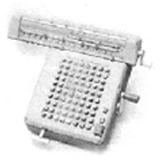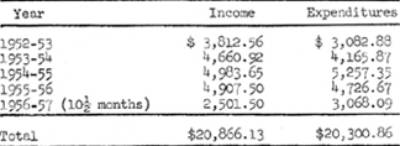First Statistical Laboratory at MSC: 1950s
In addition to teaching courses and managing the statistics curriculum, Dr. Ostle created a Statistical Laboratory to provide statistical services across the campus, Hurst tells in his 1952- 53 report:
“As long as the idea of a Statistics Laboratory is new, it does not seem desirable to charge for consultation time. Our aim should be to show the advantages of planning experimental work on a sound statistical basis. Also, the scientist should be relieved of the drudgery of routine calculations to release his time for more important work. Numerical work can be performed with greater economy by a staff organized for that purpose. This report seeks to show how we are trying to achieve these aims.”
 |
Hand-cranked rotary calculator |
The Statistical Laboratory seems to have functioned over the next several years as both a room full of calculators for students to use on their course-work lab problems as well as a service unit offering statistical consultation and data analysis. The initial location for this room of calculators is unknown, but at some time it was moved into a small room in the basement of the Math-Physics building.
Ostle, in a report to Hurst in May 1954, tells of offering 150 and 110 hours of consulting over the last two years, some for free and some for reimbursement. He used earnings to replace six obsolete calculators and to buy nine new modern ones (expanding the number of calculators to sixteen in 1955). And, he tells that a part-time person and a student assistant “in the computing room performed admirably during the past year.” Hurst reports the next year (1954-55):
” The department has done some publishing. Dr. Ostle has published "Statistics in
Research", a text filling a well-recognized need, as well as co-authored a more research
type book. He also has several minor articles. Dr. Hess finished his Ph.D. in August.
He has two articles either in print or accepted. An article by Dr. Lowney based on
his work at Aberdeen Proving Ground has recently been published.
Graduate work has been small but should be increased, partly to enable us to handle
our elementary teaching loads, but primarily to meet a real demand for college teachers
and workers in industry. The new Mathematics-Statistics Curricula should strengthen
our graduate program.
The statistics program is developing to a point where it needs additional study.
A discussion by Director Bancroft, Iowa State College, is appended so that something
of the philosophy Dr. Ostle and I are thinking about may be placed in the administration’s
hands. The consulting work is increasing in a gratifying manner. It might be desirable
if the administration emphasized this service as an overall function provided by the
college. The computing laboratory is limited largely by the lack of working funds
provided by the various departments. A common situation is for a faculty member to
find himself reduced to the drudgery of doing his own computing. The economy of this
is doubtful if it can be performed at the price of secretarial labor.
The increased IBM facilities also present the possibility of making all computing
equipment more readily available both to faculty and students. Dr. Ostle is giving
this matter special study. The Mathematics Department hopes to develop courses both
in numerical methods and operating practice consistent with trends elsewhere.”
The IBM facilities referenced in the above paragraph likely refers to punched-card equipment used by the MSC Accounting and Payroll Offices. The Statistical Laboratory data analysts may have used their card punch, sorting, tabulation and listing equipment. Ostle, with support from Bancroft, continually pushes Hurst and MSC toward a modern statistical laboratory. (see the Discussion by Director Bancroft "Role of a complete Centralized Statistical Organization in a Land-Grant College" that was appended to Hurst's report)
The letter from Ostle in June 1955 upon which the 1954-55 report was based includes (emphasis ours):
“At this time I believe we should re-examine our set-up and make plans concerning future development. My current recommendations are:
- The teaching of statistics should continue to be provided by the Department of Mathematics in the Division of Science.
- The research and consulting work should be organized under the Statistical Laboratory as a campus-wide service unit. This laboratory should be supported by a separate budget directly from the Office of the President.
- The computing service provided by the Statistical Laboratory is at present supported by charges to consumers on a ‘cost-plus’ basis. It is proposed that this practice be continued.
Dr. Bancroft’s remarks are, I believe, the best summary available of the situation with which we are concerned.“

Statistical Laboratory Balance Sheet 1952-57
Ostle summarizes the Statistical Laboratory operation over the previous five years by a letter to Hurst in May, 1957, presenting balance sheet data (right). Ostle ended his letter by mentioning again “the need for adequate space.”
Abandoning the First Statistical Laboratory
It seems that Bernard Ostle’ s original vision of a Statistical Laboratory was a service/training unit designed to administer statistical consultation, analyze research data and employ statistics-student interns. In 1958, those services were absorbed by the Computer Laboratory, which also became the location of mechanical calculators available for students to conduct course-assigned or graduate research data analysis.
Because Dr. McFeely was very busy supervising the operation of the new IBM 650, providing demonstrations to promote its use, and dealing with staff training, he surely had no time available to take on statistical laboratory tasks. He, himself, needed computer training and he attended various off-campus computer seminars. He tells in his 1958-59 report, “... have been very busy formulating policy and studying the direction of the IBM 650, which is rapidly becoming a full-time responsibility.”
Since 1958, no published references to a Statistical Laboratory have been found in MSU documents until 1975 when the idea was resurrected by Ken Tiahrt. In the 1970s, the Department's statisticians were receiving requests for statistical services and researchers across the campus were keenly interested in using the new statistical software packages.
The demise of statistical centers and growth of computer centers was a national trend as universities built centralized computing services. To do calculations, statisticians purchased computer time from a computer center. Mechanical calculators were less used and support moved from statistics labs to computer centers. As happened at MSU years later when personal computers became ubiquitous, the trend reversed, favoring statistical consulting and collaboration centers.
Next topic (Computer Laboratory)
Table of Contents
Last revised: 2021-06-04
